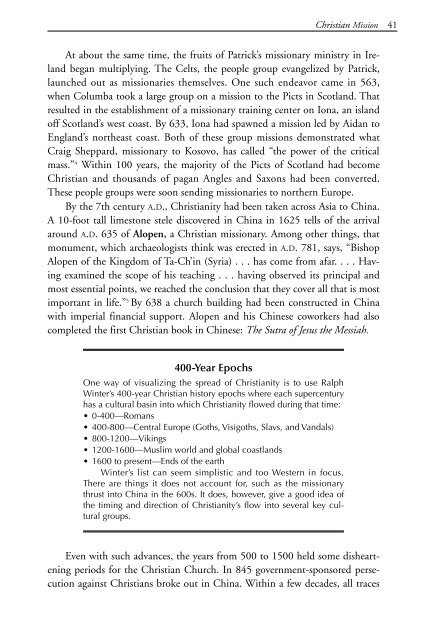discovering missions - Southern Nazarene University
discovering missions - Southern Nazarene University
discovering missions - Southern Nazarene University
Create successful ePaper yourself
Turn your PDF publications into a flip-book with our unique Google optimized e-Paper software.
245187 Disc Missions ins 9/6/07 1:04 PM Page 41<br />
At about the same time, the fruits of Patrick’s missionary ministry in Ireland<br />
began multiplying. The Celts, the people group evangelized by Patrick,<br />
launched out as missionaries themselves. One such endeavor came in 563,<br />
when Columba took a large group on a mission to the Picts in Scotland. That<br />
resulted in the establishment of a missionary training center on Iona, an island<br />
off Scotland’s west coast. By 633, Iona had spawned a mission led by Aidan to<br />
England’s northeast coast. Both of these group <strong>missions</strong> demonstrated what<br />
Craig Sheppard, missionary to Kosovo, has called “the power of the critical<br />
mass.” 4 Within 100 years, the majority of the Picts of Scotland had become<br />
Christian and thousands of pagan Angles and Saxons had been converted.<br />
These people groups were soon sending missionaries to northern Europe.<br />
By the 7th century A.D., Christianity had been taken across Asia to China.<br />
A 10-foot tall limestone stele discovered in China in 1625 tells of the arrival<br />
around A.D. 635 of Alopen, a Christian missionary. Among other things, that<br />
monument, which archaeologists think was erected in A.D. 781, says, “Bishop<br />
Alopen of the Kingdom of Ta-Ch’in (Syria) . . . has come from afar. . . . Having<br />
examined the scope of his teaching . . . having observed its principal and<br />
most essential points, we reached the conclusion that they cover all that is most<br />
important in life.” 5 By 638 a church building had been constructed in China<br />
with imperial financial support. Alopen and his Chinese coworkers had also<br />
completed the first Christian book in Chinese: The Sutra of Jesus the Messiah.<br />
400-Year Epochs<br />
One way of visualizing the spread of Christianity is to use Ralph<br />
Winter’s 400-year Christian history epochs where each supercentury<br />
has a cultural basin into which Christianity flowed during that time:<br />
• 0-400—Romans<br />
• 400-800—Central Europe (Goths, Visigoths, Slavs, and Vandals)<br />
• 800-1200—Vikings<br />
• 1200-1600—Muslim world and global coastlands<br />
• 1600 to present—Ends of the earth<br />
Winter’s list can seem simplistic and too Western in focus.<br />
There are things it does not account for, such as the missionary<br />
thrust into China in the 600s. It does, however, give a good idea of<br />
the timing and direction of Christianity’s flow into several key cultural<br />
groups.<br />
Christian Mission 41<br />
Even with such advances, the years from 500 to 1500 held some disheartening<br />
periods for the Christian Church. In 845 government-sponsored persecution<br />
against Christians broke out in China. Within a few decades, all traces

















